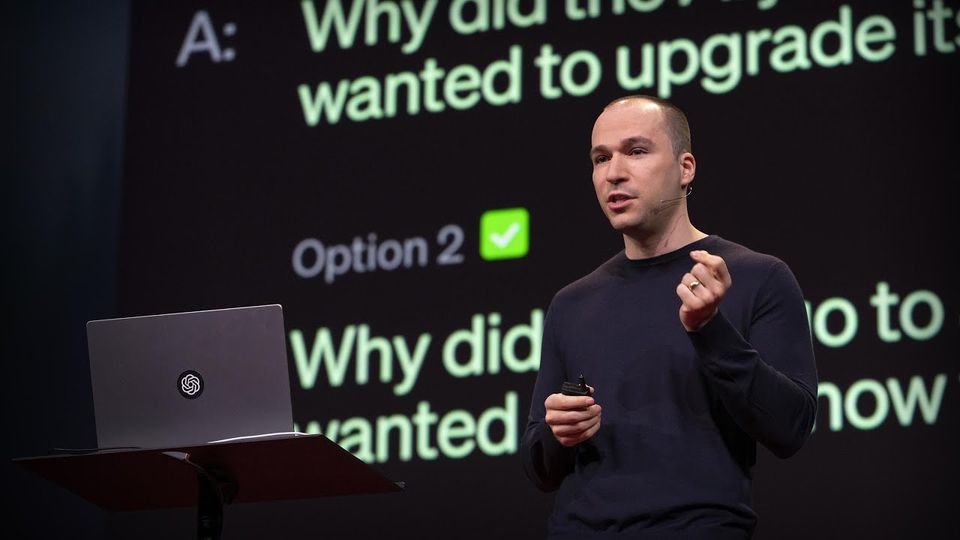The Inside Story of ChatGPT’s Astonishing Potential: Greg Brockman - TED | Summary and Q&A

Summary:
The video discusses the capabilities of artificial intelligence systems like ChatGPT and how OpenAI is developing them responsibly through incremental deployment and human feedback. It demonstrates how these systems can be used to generate images, check facts, analyze data, and more. The key is scaling up the models and providing high-quality human feedback to teach the AI beneficial skills. OpenAI aims to steer AI progress in a positive direction by releasing systems incrementally so people can provide input on how to align them with human values before they become too powerful. There are risks, but also huge potential, so it's important for society to participate in shaping this technology.
- OpenAI was founded 7 years ago to steer AI development in a positive direction. They've made deliberate choices like confronting reality and getting diverse teams to work together.
- They use an old idea from Alan Turing - teach AI like a human child with rewards and punishments as it tries things. This allows it to generalize.
- They released ChatGPT incrementally so people can see it in action and provide feedback on areas of weakness before it's more powerful.
- The technology looks different than people expected - we need to become literate and provide high-quality feedback. Together we can ensure it benefits humanity.
- It's a child with potential superpowers - our responsibility to provide guardrails, teach it wisdom, not let it tear us down. We must take each step carefully as we encounter it.
Questions and Answers:
Q: How is OpenAI able to develop such powerful AI systems like ChatGPT when tech giants like Google have far more resources?
A: OpenAI made deliberate choices to confront the realities of AI progress head-on and get different experts to work together effectively. They also recognized the potential of scaling up language models years ago and invested heavily in that direction. Careful software engineering to enable smooth scaling curves and prediction of emergent capabilities has also been key.
Q: What was an early indicator that scaling up language models could produce surprising new abilities?
A: In the early days, a model trained to simply predict the next character in Amazon reviews developed an unexpected ability to classify sentiment. This showed the semantic capabilities that could emerge from models focused on syntactic prediction.
Q: If these systems are prediction machines, how can they produce such impressive results that seem to demonstrate understanding?
A: As you scale up the amount of data and parameters in the models, new abilities can emerge that go beyond what the original training setup entailed. Like ant colonies or cities, simple individual components can exhibit complex collective behaviors when combined in large numbers.
Q: What are some examples of abilities that shocked the OpenAI team as they scaled up models?
A: The models became able to add very long numbers, suggesting an emerging general capability for arithmetic. But they struggled with numbers of different lengths, showing the learning process wasn't complete. More recently, ChatGPT can summarize books, generate images, analyze datasets, and more based just on natural language instructions.
Q: Isn't there a huge risk of something dangerous emerging as the models continue to scale up?
A: Yes, capabilities could emerge that are undesirable, but OpenAI aims to deploy systems incrementally so people can provide feedback and steer the technology in a positive direction. Right now tasks are inspectable, but as they get more complex like summarizing books, better oversight methods will be needed. It's an ongoing responsibility.
Q: How does OpenAI respond to critics who say these systems don't really understand anything and just generate plausible-seeming output?
A: The feedback and prompting mechanisms allow human trainers to shape the system's responses and teach it to align with human preferences. This instills a form of understanding oriented around benefiting users. Perfect reasoning isn't needed initially, just good enough performance guided by human input.
Q: Do you believe these systems will eventually reach human levels of general intelligence?
A: There's still a long way to go, but the smooth scaling curves and new abilities emerging suggest the fundamental approach is sound. We have to take it step-by-step, but if today's trends continue, the systems could someday rival humans across many dimensions of intelligence.
Q: What was an example Greg gave of something they had to specifically train ChatGPT to do that surprised them?
A: When first testing ChatGPT with Khan Academy, the system would happily accept incorrect math from students instead of correcting it. OpenAI had to collect feedback data from Sal Khan and others over several months to train ChatGPT to push back on bad math, since that level of skepticism wasn't in its original training.
Q: How does OpenAI use AI systems themselves to provide better feedback and oversight?
A: An example is having ChatGPT write out explanations for how it researched a fact using internet search tools. This helps human trainers efficiently validate the chain of reasoning. The goal is for AI systems to assist with their own regulation and alignment.
Q: What guardrails and oversight does OpenAI put in place when releasing a new system?
A: They aim to deploy capabilities incrementally so there is time for inspection and adding safeguards as needed. For example, ChatGPT won't impersonate others, harm users, or provide illegal or unethical advice. Content filters block inappropriate responses. Access controls and monitoring help align it to human values.
Q: What does Greg see as an alternative model for developing AI responsibly compared to OpenAI's approach?
A: The default approach of developing AI secretly and then hoping you've solved the safety problems before releasing it is unlikely to succeed. OpenAI's model of public input and incremental deployment, while difficult, provides more opportunity to align the technology as it advances.
Q: Does Greg think powerful AI systems will become a reality regardless of what OpenAI does?
A: Progress in compute, algorithms, and data make some advancement inevitable. OpenAI wants to guide this transition, rather than leaving an unstable power vacuum if others develop transformative AI first without concern for ethics and safety.
Q: What does Greg see as some of the most positive uses of large language models like ChatGPT?
A: Applications like assisting Khan Academy illustrate the potential for personalized education. Other promising areas are code generation to increase programmer productivity, analyzing scientific papers, automating routine coding tasks, and creatively brainstorming ideas as the system did for the TED dinner prompt.
Q: Is there a risk that reliance on systems like ChatGPT could atrophy human skills and capabilities?
A: Yes, it's important to stay vigilant about overreliance on AI. But when designed well, these systems can play a complementary role - providing raw processing power while leaving key decisions and creativity to humans. The goal should be augmenting human abilities, not replacing them.
Q: Could advanced AI systems become biased if the training data has societal biases baked in? How does OpenAI address this?
A: Absolutely, biases in the data can lead to biased behavior. OpenAI researches techniques to reduce undesirable biases and builds controls into the systems. But monitoring for issues and actively counteracting biases through targeted human feedback will remain critical.
Q: Does OpenAI patent its AI innovations? If not, how will it stay competitive with large profits-driven tech companies?
A: OpenAI uses an open research model - they don't patent their work to help accelerate overall progress in AI safety. Relying on talented staff and key partnerships, they aim to lead in both capabilities and ethics. Remaining a top destination for AI experts is part of sustaining this model.
Q: What role does OpenAI see for government regulation as AI systems grow more advanced?
A: Some government oversight will likely be important, but too restrictive regulations could also stagnate progress. OpenAI wants to demonstrate responsible development in hopes of informing policies that allow rapid innovation while ensuring AI benefits humanity.
Takeaways:
OpenAI was founded to steer AI development toward benefitting humanity, making deliberate choices like transparently confronting challenges and fostering diverse collaboration. Their approach involves incrementally releasing systems like ChatGPT to gather public feedback, teaching the AI like a child while it's still manageable. This emerging technology looks different than anticipated - it may have unforeseen superpowers, presenting risks if not guided wisely. Our collective responsibility is to become literate in AI, provide guardrails and nurturing guidance as it grows, shaping a collaborative future where machines enhance rather than replace human potential. Progress requires openness to reality, multi-stakeholder partnership, and step-by-step vigilance in aligning AI with human values as capabilities scale.
Relevant Books:
- "Life 3.0: Being Human in the Age of Artificial Intelligence" by Max Tegmark - explores benefits and risks of AI, how to align it with human values
- "Human Compatible: Artificial Intelligence and the Problem of Control" by Stuart Russell - argues for AI that is provably aligned with human values
- "The Master Algorithm : How the Quest for the Ultimate Learning Machine Will Remake Our World" by Pedro Domingos - looks at machine learning techniques and the quest for general AI
Relevant Articles:
- "Building Safe Artificial Intelligence" by Dario Amodei et al - OpenAI research on AI safety challenges like scalable oversight
- "Regulating AI: beware of toxicity taxes" by Jack Clark - argues for careful, incremental AI regulation vs bans
- "The Morality of Artificial Intelligence" by Wendell Wallach - philosophical perspectives on imbuing AI with human values
Relevant Organizations:
- Center for Human-Compatible AI - UC Berkeley research center on AI safety and benefits for people
- Partnership on AI - industry consortium studying AI's social impacts
- AI for People - non-profit building trustworthy AI to empower vulnerable populations
